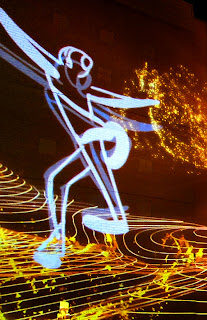 |
| Shot through a kitchen window using a Fuji FinePix HS10 shooting RAW. |
For years I resisted shooting RAW. I used a couple of high end Canon DSLR cameras shooting for the newspaper and these cameras did just fine shooting jpgs. A powerful program like Photoshop had no difficulty colour correcting my shots and when working to deadline most of us in the photo department found jpgs quicker to correct and send off to the desk than RAW images. One shooter actually shot RAW briefly and then switched back to jpg. For me, this confirmed that shooting jpgs was the way to go at the paper.
That said, since leaving the paper a big disappointment for me has been the incredible amount of processing performed on jpg images by point and shoot amateur cameras. My early Canon SD10 wasn't anywhere near as sophisticated as todays cameras and I believe it was a much better camera for it.
My Canon S90, as nice a camera as it is, has some faults that are making me question whether or not I have been too accepting. For instance, the in-camera processing will sometimes blur areas in the image. Sharpening and blurring are both done in-camera when saving jpgs but neither is carried out on RAW files.
Unfortunately, shooting RAW turns off the image enhancement features you want along with the ones you don't. The Canon S90 lens suffers from a lot of distortion at wide angle. For the most part, the photographer shooting jpg does not see this. The in-camera computer corrects this distortion before saving the images as jpgs. Shoot RAW and the distortion will be there to see. No in-camera correction.
So, why am I thinking of shooting RAW? I got a real deal on Photoshop a year or so ago. I've got software powerful enough to fix any distortion. Render intricate detail as blurry mush and there is no amount of Photoshopping that will bring back the missing visual information.
Look at the far left of this image, at the little rabbit's rump, do you see how blurry the fur is. My guess is this fur would be detailed if shot using RAW rather than jpg.
For a more detailed discussion of shooting jpg vs. RAW, here is a link to a fine technical site:
Understanding RAW
There was a time I was an I-care-about-the-science kind of photographer. I used to try water bath development to capture detail in church windows while holding detail in the dark, shadowy pews. Slow, I had those concerns beaten out of me. I learned that three years of art school and more years spent at Ryerson earning a degree all worked to fill me with far too much fear.
I learned to focus on the subject to the exclusion of everything else, to strive for images that could be delivered quickly to the desk while capturing the subject accurately enough to keep the editors happy. Heck, by the time a reader saw my shot it had been translated into a halftone, separated into three colours and printed on newsprint. One could easily get too concerned with quality, quality that would never make it to the reader.
Now, some years into my retirement, I am starting to think it may be time to get back to my roots and spend some time getting a good handle on this digital photography beast. It may be time that I learned what my computer-that-takes-pictures (my digital camera) is really up to. The world of silver halide is gone and maybe I need to get in step with the changes.
--- As you may have noticed, this is more a blog than a source of great photographic insight. Follow my tips and you'll be a better shooter but that's all. Maybe better isn't enough. Maybe I should raise the photo quality bar. ---



















